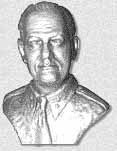



C.R. Smith
(1899-1990)
Cyrus Rowlett Smith became president of American Airlines in 1934 at the age of 35. In the 34 years he led the airline, "Mr. C.R." helped shape the airline industry and influenced the world of aviation. He was a true aviation pioneer, entering the airline business in the day of open-cockpit biplanes, and built American from a small and unprofitable carrier into one of the largest airlines in the world.
Life before the airline business
Born September 9, 1899, in Minerva, Texas, C.R. was the eldest of seven children. At nine years old, he secured his first job: office boy to cattleman C.T. Herring. Young C.R. Smith also worked as a cotton picker, store clerk, bookkeeper and bank teller. Before he had even finished school, C.R. Smith received permission to enter the University of Texas at Austin, where he studied business administration, economics and law. In 1924, he became an accountant with Peat, Marwick, Mitchell and Company in Dallas. One of the firm's clients, A.P. Barrett, owned the Texas-Louisiana Power Company. He noticed the young accountant and hired Smith as assistant treasurer for the utility company.
A career takes flight
Barrett purchased Texas Air Transport in 1928 and appointed C.R. Smith secretary and treasurer. The next year, Barrett launched Southern Air Transport (SAT), which absorbed Texas Air Transport, and retained Smith as vice president and treasurer. Later that year, SAT became part of the Aviation Corporation (AVCO). In January 1930, AVCO's directors created American Airways and appointed C.R. Smith vice president for the Southern Division. In April 1934, American Airways became American Airlines. C.R. Smith was elected president of American Airlines on October 25, 1934.
Building a legendary company - and serving the country
To all members of the American Airlines organization, C.R. Smith was "Mr. C.R.," or simply "C.R." Over the next five years, he consolidated American's crazy-quilt routes into a smooth, sensible network and standardized the company's collection of various airplanes with a fleet of new DC-3 aircraft. Smith was influential in the design of the DC-3, which would become the "workhorse" of passenger planes in the 1930s and 1940s.
When the United States entered World War II, C.R. Smith joined the Army Air Forces as a colonel and helped organize the Air Transport Command. Colonel Smith soon became General Smith and finally Major General, serving as Deputy Commander of the Air Transport Command when the war ended. After his military career in 1945, Mr. C.R. returned to American Airlines.
Smith led American Airlines into the jet age with the introduction of the first transcontinental jet service on January 25, 1959.
In early 1968, C.R. Smith retired as chief executive of American Airlines when his longtime friend, President Lyndon B. Johnson, appointed him Secretary of Commerce.
In 1973, American's Board of Directors asked Mr. C.R. to return as interim chairman while they searched for a permanent chief executive. He remained until Albert V. Casey was elected chairman.
Following his retirement, C.R. Smith remained active in civic affairs in Washington, D.C. He died on April 4, 1990, at the age of 90 and was buried at Arlington National Cemetery.